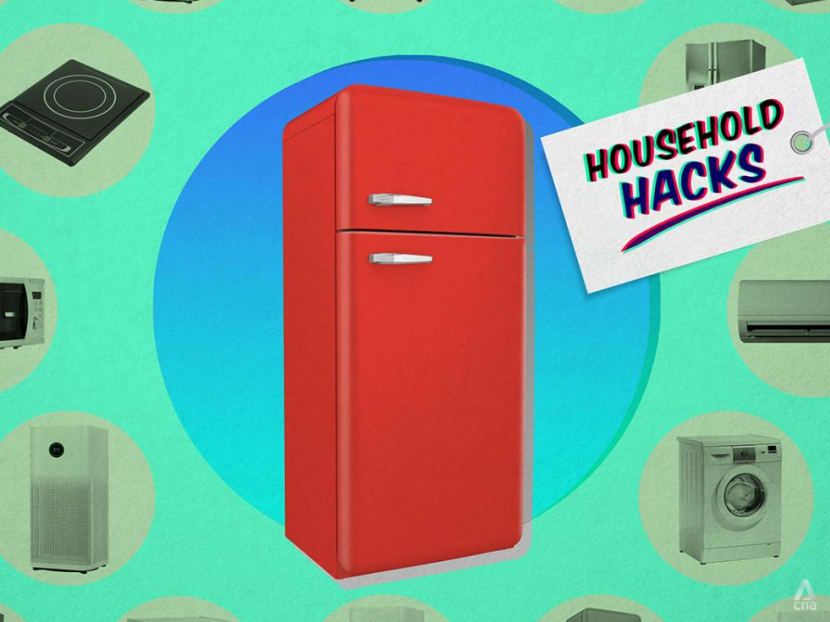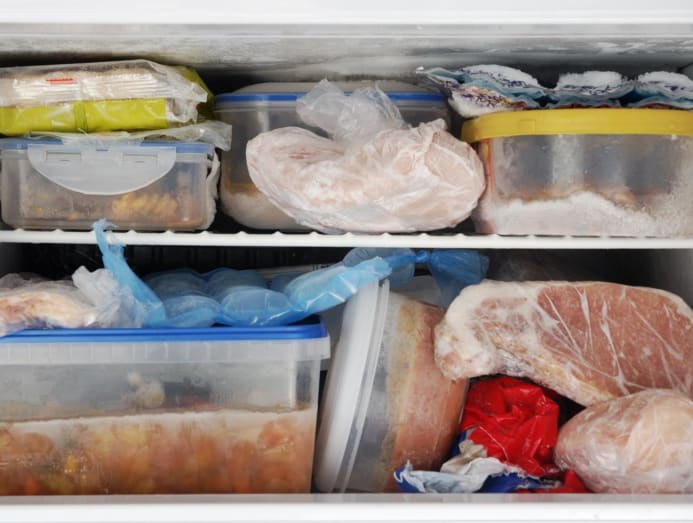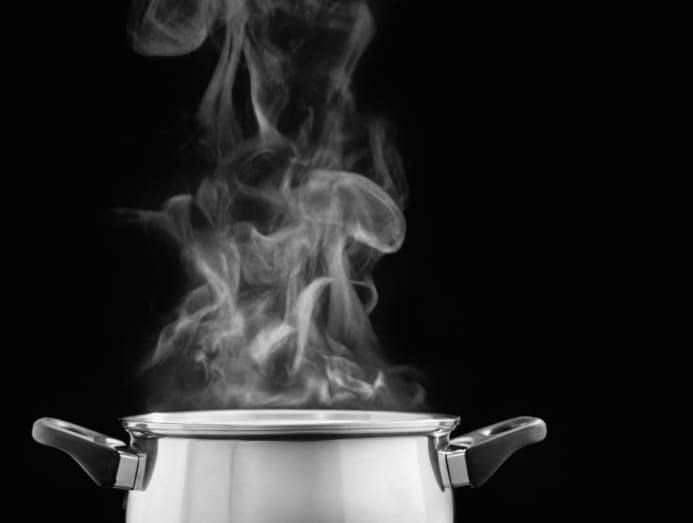Is it okay to put hot food inside a fridge? And what happens when you overload the freezer?
In our ongoing Household Hacks series, we turn our attention to the refrigerator. What’s the best way to organise your food items? How often should you be cleaning it? And why is there water leaking?

(Art: Jasper Loh)
Not counting your splurge on fancy gadgets, the family refrigerator is probably one of the most expensive items in your kitchen: About S$1,436 on average for a medium-sized model, or one with a capacity of 300 litres to 400 litres, according to this article.
However, when it comes to fridge care, you probably don’t think much about it. As long as there is no food spillage messing up the interior, there’s no need to clean regularly, right?
Not quite, because regular cleaning can minimise bacterial and fungal growth inside the compartments as well as optimise the seal of the fridge and freezer, said Dr Tang Kok Zuea, a senior lecturer from National University of Singapore's College of Design and Engineering, Department of Electrical and Computer Engineering.
That checks both your health and wealth when you consider the doctor’s and electricity bills you’ll save on.

Cleaning the interior every two weeks should do the trick, said Dr Tang, and with soap and water. “Removable shelves and drawers should be washed to prevent bacterial and fungi growth on them. Dry these parts before putting them back,” he advised.
Don’t forget to wipe the door’s seal with soap and water, too. “Regular cleaning will be beneficial in ensuring a good seal of the fridge and freezer,” said Dr Tang. Every week, check the content of your fridge, and discard food that has turned bad or has expired, he added.

WHERE TO KEEP THE DIFFERENT FOODS?
Speaking of food, there are spots in the fridge that are better suited for some foods than others because of the temperature consistency. For instance, the top shelf is usually where the cold air vents are and the temperature here is the most consistent, said Dr Tang. This spot is good for already-cooked foods such as leftovers, he said.
The coldest place in the fridge is the bottom shelf as cold air sinks. “Meat, seafood and eggs should be placed on the bottom shelf to maintain their freshness,” he continued. To avoid cross-contamination, “use sealed containers to ensure that these foods do not drip onto the other items below them or touch the other foods around them.”
And of course, keep your fruits and vegetables in the crisper compartment to “ensure that the moisture content of these foods is maintained before consumption”, said Dr Tang.

As for the shelves on the fridge door, keep foods that can withstand changing temperatures there, such as condiments, beer, plain water and canned drinks, he suggested. These compartments are also designed for easy access so, depending on your diet strategy, you can (or maybe not) keep your sweets and chocolates here, too.
Now that you have that down pat, here’s a look at some common questions and scenarios that you may experience with your fridge and built-in freezer, and how to solve them.
SCENARIO 1: The temperature doesn't feel cold enough even after adjusting the thermostat
For starters, the recommended temperature range of the fridge is between zero degree Celsius and four degrees Celsius, said Dr Tang. For the freezer section, keep it at -18 degrees Celsius. Any readings above those recommended temperatures, and bacterial and fungi growth can occur quickly, he said.
Now, the temperature problem. There are a few reasons why the fridge feels warmer than you like or the freezer is taking exceptionally long to make ice cubes, said Dr Tang. A faulty thermostat or built-in temperature sensor could be a cause.
A more serious issue may involve the malfunctioning of the electrical and electronics parts such as the heat exchange unit, condenser unit and evaporator unit, he said. “In such situations, the coolant’s cycling process that runs inside the fridge doesn’t complete well to achieve the fridge’s cooling capability.”
Also, check the door’s seal to ensure that there is no leakage of cold air. “In Singapore’s hot weather, the loss of cold air could be significant. This would also lead to the fridge overworking,” said Dr Tang.
Your daily activities can affect how your fridge works as well. Overloading it with too much food is one. The fridge’s cooling effect relies on good air circulation and stuffing the fridge full of items means the cool air is not able to reach everything, he explained.
Your door activity (yup, all those times you open the fridge to see what tasty morsels you can find) is another factor. Opening the fridge door too often will cause the temperature to rise. More importantly, this will lead to a higher electricity bill, said Dr Tang.
Speaking of doors, their improper handling such as slamming could lead to the misalignment of the hinges and damage to the seal over time, he said. So it helps to show your fridge some TLC.
Before you call a repairman, do these things first: Remove spoiled and expired food to free up space for the cold air to circulate. Make sure the cold air vents inside the fridge are not blocked by items. Limit the times you open the door to allow for the temperature to drop evenly, advised Dr Tang.
Next, place a digital thermometer that is able to read below zero degree Celsius to assess if the thermostat in the fridge or freezer is still working, he said.
Place the thermometer near the centre of the refrigerator in a spot where you can read its measurements without removing it and close the door. Leave the thermometer there for 10 to 15 minutes, advised the Singapore Food Agency website. If the temperature reading is off and you’ve already taken the abovementioned steps, it’s time to call the repairman.

SCENARIO 2: You often put hot food in the fridge without waiting for it to cool down
It can be a “good and fast resort to cool down hot food”, said Dr Tang. It is also safer than letting your pot of curry cool down in room temperature because during that time, harmful micro-organisms may thrive.
But if the thought of putting a pot of piping hot food in the fridge bothers you, Dr Tang has this suggestion: Separate the hot food into smaller containers first. It’ll cool down the food in a quicker manner and doesn’t create “one sudden hot spot” that would cause the fridge to push the production of cold air suddenly.
You can also let the food cool down for no more than two hours first before putting it into the fridge.

SCENARIO 3: There is water leaking from the fridge
Your fridge may not be well balanced and this affects the flow of the coolant in the cooling system, said Dr Tang. "This issue will usually occur when you have just moved the fridge to a new location. To correct the balance, adjust the legs according to the operating manual of your fridge model."
If your fridge is a fancy model that can produce cold water and ice on demand, check that the tubing that supplies water to the fridge is not faulty or clogged, said Dr Tang.
“In some fridges with automated defrost functions, the drainage parts may be blocked or faulty,” he added.

SCENARIO 4: The cooling unit cycles too often
What is considered a normal sound when the fridge’s cooling unit is cycling is a low hum, said Dr Tang. “A click could also be heard when the compressor is started.” As for a “regular” frequency, it depends on your fridge’s capacity and usage, he said. “A typical cycle could be every four to five hours.”
If your fridge is cycling way too frequently, there could be a few reasons, said Dr Tang. There may be an improper or faulty power connection to the socket. “This causes the unit to always restart its initialisation operation.”
A faulty thermostat or built-in temperature sensor could be another cause of short and frequent cycling issues. “For more serious conditions, the electrical and electronics parts may have malfunctioned. In such situations, the cycling process of the fridge is unstable,” said Dr Tang. In other words, get the pros to have it assessed.







